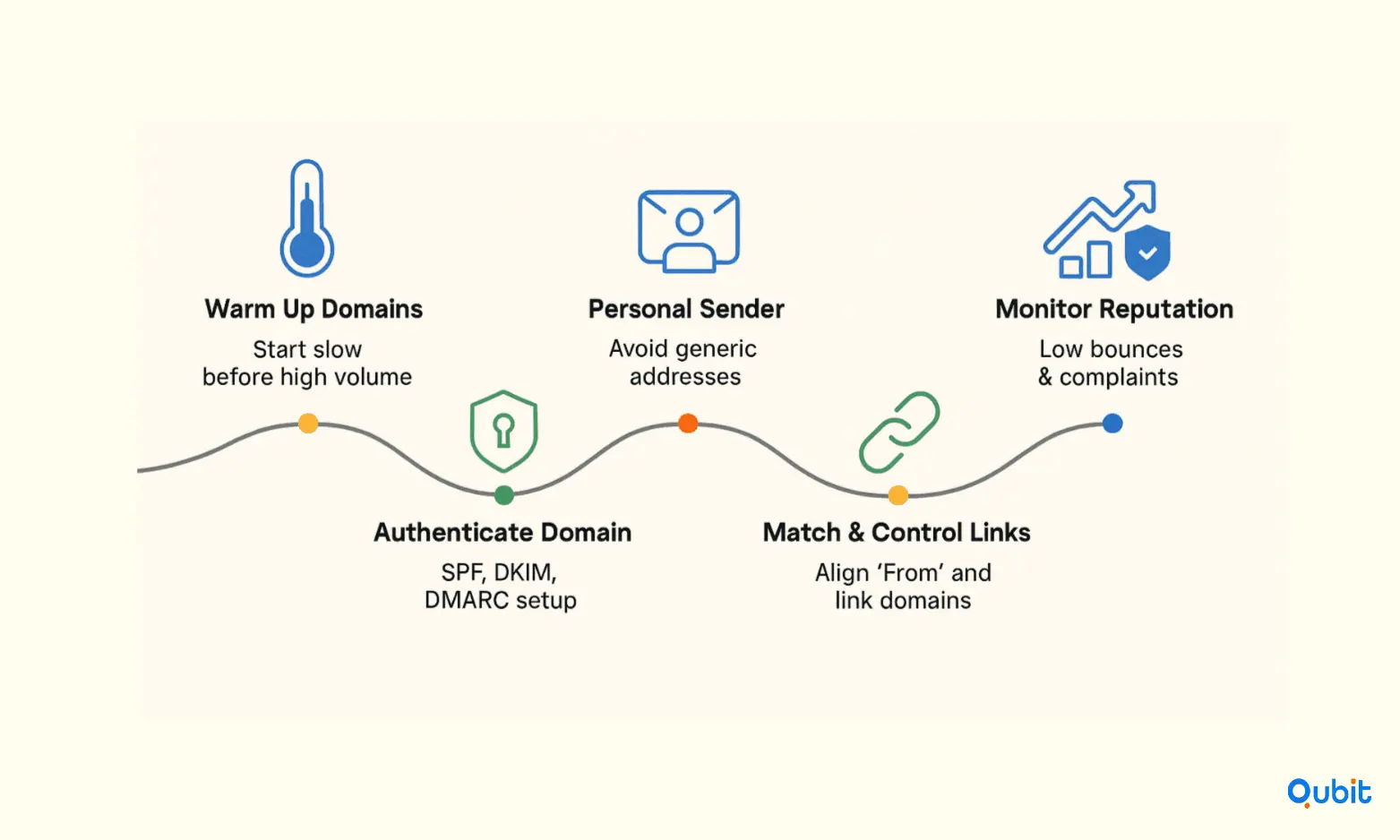High-quality founder responses don’t come from volume, they come from relevance, clarity, and respectful follow-up grounded in deliverability fundamentals and clean structure. Cold or warm, the best investor emails are short, specific, and personal, with a single clear ask and no friction to reply.
Below is a practical playbook with ready‑to‑use templates investors can adapt for first contact, follow‑ups, intros, and post‑event reach‑outs, plus guidance on subject lines, timing, and domain setup so messages actually land in inboxes.
What Makes Founders Reply
Effective investor outreach consistently follows four principles: tight targeting and personalization, concise copy, one focused call‑to‑action, and disciplined follow‑ups spaced respectfully. Overly long emails, generic language, and multiple asks depress reply rates, while clear subject lines and tailored references raise open and response rates in B2B contexts. Deliverability hygiene, SPF, DKIM, and DMARC authentication, protects domain reputation so even great copy isn’t trapped in spam.

Subject Lines That Earn Opens
Short, specific subject lines outperform vague or salesy phrasing, with concise formats and personalization driving higher open and reply rates. Keep it under ~5 words when possible, ask a relevant question, or reference a concrete context (event, thesis, mutual connection) to signal credibility and fit. This trust-building aspect is particularly relevant when fostering relationships, such as learning how to build investor-founder relationships, where credibility plays a pivotal role.
- Examples:
- “Intro + quick ask?”
- “Fintech buyer fit question”
- “Congrats on launch—1 idea"
- “Following up post [event]”
- “[Vertical] pilot question”
How Long Should Your Email Be?
A well‑crafted investor outreach email should generally fall between 75–200 words. This length is long enough to provide context and relevance, but short enough to hold the founder’s attention, especially when they’re juggling product development, hiring, and customer acquisition.
Going beyond this range risks introducing too much cognitive load, making it harder for the recipient to quickly understand who you are, why you’re reaching out, and what next step you’re proposing. Inboxes get crowded, and lengthy messages tend to be scanned or skipped.
Within this word range, aim to:
- Personalize early — Reference a recent, credible signal (launch, partnership, funding, hiring) in the first two lines.
- Avoid multiple CTAs — One clear ask per message increases reply probability.
- Keep paragraphs short — 2–3 sentences each for easy reading on mobile.
- Lead with value — State what’s in it for them before asking for their time.
- Make next steps easy — Suggest 2–3 specific time slots to reduce friction.
Benchmarks from B2B email campaigns (including investor–founder outreach) consistently show that concise, benefit-driven notes with one CTA outperform longer, multi-topic, “about us” style emails, both in open rates and actual meeting conversions.
For businesses aiming to create value beyond traditional methods, examining how investors add value beyond capital offers additional perspectives. This strategy aligns seamlessly with the broader goals of thought leadership, emphasizing the importance of creating meaningful, long-term connections.
Example Email Templates for Different Scenarios
Template 1: First‑Touch Cold Email (Investor to Founder)
Subject: Quick question on [buyer/problem]
Hi [Founder Name], I invest in [vertical/ICP] and noticed [credible signal: launch, integration, hiring, customer logo] last week. Two things stood out: [specific buyer pain or ROI lever] and your angle on [differentiator], which aligns with what we see across [segment/ICP].
I’d love 15 minutes to learn how teams are adopting [category] and share 1–2 intros to design partners in [buyer segment] if helpful. Would [Tue 11:00] or [Wed 14:00] work?
Either way, impressive progress and congrats on [signal].
Best,
[Name], [Fund]
[Optional: 1‑line context, stage focus or relevant portfolio]
Why this works: It anchors on a recent signal, offers a specific “give,” proposes two times, and keeps one clear CTA—all best practices for founder outreach.
Template 2: Warm Intro Email (Mutual Connection or Event Thread)
Subject: [Mutual contact/event] → quick chat?
Hi [Founder Name]—[Mutual contact/event] suggested I reach out after your update on [topic]; the [metric/proof] you shared on [buyer outcome] was compelling.
My focus is [sector/ICP] with recent work on [adjacent problem], including [short, relevant example], so I may be useful on [distribution/compliance/pilot‑to‑paid]. Open to a brief chat this week? [Thu 10:30] or [Fri 09:00] both free.
Thanks, and congrats again on [specific milestone].
Best,
[Name], [Fund]
Why this works: Social proof and context reduce friction, and specificity prevents it from reading like a mass mailer.
Template 3: Founder‑Friendly Follow‑Up (No Reply Yet)
Subject: Worth a quick chat on [buyer/problem]?
Circling back in case my note was buried, still happy to share 1–2 intros to [ICP] design partners and compare notes on [metric/ROI angle]. If not a fit now, I’ll step back and check in post‑[milestone, e.g., SOC2/pilot].
Is [Tue 11:00] or [Wed 14:00] better, or should I follow up in a month?
Best,
[Name]
Why this works: Short, respectful, value‑forward, and gives an easy out; follow‑ups measurably lift reply rates when done thoughtfully.
Template 4: Post‑Event/Program Outreach (Incubator/Accelerator/Conference)
Subject: Following up from [program/event]
Great to hear the update on [feature/metric] at [program/event]—the angle on [specific buyer job‑to‑be‑done] stuck with me. I can likely help on [distribution/compliance/design partners] within [ICP/geography] based on recent work with [relevant example].
If useful, could do 15 minutes to compare notes and triage next steps—[Thu 10:00] or [Fri 13:30]?
Congrats again on the momentum.
Best
[Name]
Why this works: References the exact context and proposes a small, specific next step, which increases conversion from events to meetings.
Template 5: Pass‑With‑Value (Preserve Relationship)
Subject: Not a fit right now, two helpful paths
Thanks for the thoughtful convo, impressive progress on [signal]. We’re passing for now given [stage/mandate fit], but I’d recommend [operator/partner] for [specific need], and happy to intro if useful. If you’re open, let’s revisit after [milestone, e.g., pilot conversion/security review], likely [timeframe].
Appreciate the time, and cheering you on.
Best,
[Name]
Why this works: Clarity plus a concrete “give” preserves goodwill and invites a timed re‑engagement instead of going dark.
Formatting and Copy Rules That Move the Needle
- Personalization first, brevity always: reference one real signal and keep the note tight; personalized outreach materially boosts replies in B2B benchmarks.
- One ask per email: request a 15–20 minute chat or a single artifact; multiple CTAs lower response probability.
- Avoid link dumps and heavy attachments: many investors and founders caution that fewer links and clean text improve deliverability and scanning, especially on mobile.
- Make it easy to say yes: offer 2–3 time slots and invite alternatives to reduce back‑and‑forth friction.
Credibility is a critical factor in cultivating impactful relationships. An analysis of reputation building appears in investor-thought-leadership, which demonstrates how thought leadership contributes to establishing a credible presence with founders.
Follow‑Up Cadence and Timing
A simple, effective cadence is one initial email and one polite follow‑up 3–5 days later; if no response, wait a few weeks and nudge around a relevant milestone or new signal. Mid‑week, mid‑morning sends are commonly effective windows, though testing against the target segment is recommended.
Deliverability Checklist: Don’t Get Filtered
Even the best-crafted outreach email fails if it never reaches the inbox. To avoid spam folders, make sure your sending domain is authenticated and that your emails look trustworthy to both filters and readers.
Warm up new domains gradually before high-volume sending to build trust with mailbox providers.

Authenticate your domain using SPF, DKIM, and DMARC.
- SPF tells mail servers which platforms can send on your behalf.
- DKIM adds a cryptographic signature proving the email wasn’t altered in transit.
- DMARC ties these checks together and lets you set rules for handling failures, plus it sends reports so you can spot spoofing or configuration gaps.
- Keep sender details personal. Avoid generic addresses like info@ or sales@. Founders respond better to a named sender (e.g. [email protected]), and personal addresses often land in Primary inbox tabs rather than Promotions.
- Maintain consistency. Make sure the “From” address matches your sending domain and that links in the email point to domains you control. Mismatched domains can trigger spam filters.
- Monitor reputation. Keep bounce rates and complaints low, and never blast unverified or scraped lists. Domain reputation, once damaged, takes time to rebuild.
Putting It Together: A Minimal Outreach Workflow
- Research and shortlist on‑thesis founders, then draft personalized first touches tied to one recent signal and a specific “give”.
- Send concise emails with a single CTA and 2–3 time options, then follow up once, politely, inside a week if there’s no response.
- Track replies and iterate subject lines, length, and value offers; segmentation, personalization, and disciplined follow‑ups raise reply rates in high‑fit segments.
- Maintain domain hygiene with SPF/DKIM/DMARC and avoid bounces or spam triggers to protect program‑wide outreach efficacy.
Conclusion
The perfect investor outreach email is a blend of brevity, personalization, and a clear, founder‑friendly ask. Keeping your message to 75–200 words forces discipline, making you prioritize relevance over biography and value over volume. Combine this with clean subject lines, deliverability hygiene, and respectful follow‑ups, and you’ll stand out from the generic “spray and pray” messages that inboxes are full of.
If you're looking to connect with investors who align with your vision, we at Qubit Capital can assist. Explore our Investor Discovery and Mapping service to identify strategic partners tailored to your needs.
Key Takeaways
- Stay within 75–200 words to keep attention and respect the founder’s time.
- Personalization, a recent credible signal, and a single CTA are essential anchors.
- Mobile‑friendly formatting (short paragraphs) boosts readability and response rates.
- Offer value upfront—a warm intro, potential customer, or relevant insight.
- Protect deliverability with proper domain authentication and minimal attachments/links.
Frequently asked Questions
Why is 75–200 words the sweet spot?
It provides enough space to prove relevance and offer value without overwhelming the reader—shorter emails are more likely to be read in full.






